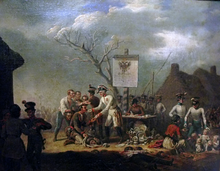Galician peasant uprising 1846
The Galician peasant uprising in 1846 , led by Jakub Szela (1787–1862 or 1866) was directed against the serfdom of the peasants and their exploitation. Over 1000 Polish landowners, some priests and officials died, and around 470 mansions were destroyed.
The Starost (District Administrator) of Tarnów , Joseph Breinl von Wallerstern , allegedly incited the farmers against Polish landowners. At the same time there was the Cracow uprising , which aimed at the reunification of Poland and whose planning was overshadowed at an early stage by the Austrian and Prussian secret services. The unrest in Galicia had initially been secretly tolerated by the Austrian authorities. The uprising lasted from February 19 to the end of March 1846 and was finally suppressed by Austrian troops because of its connection to the Cracow uprising.
After the end of the uprising Jakub Szela was awarded a medal by the Austrian authorities and brought to Bukowina , where he remained until the end of his life.
The peasant uprising in 1846 created a level of distrust between the Polish peasant people and the educated classes that lasted until the end of the 19th century. It wasn't until the Cracow bohemian era that the upheaval came about at the turn of the 20th century. Many young Krakow artists such as Stanisław Wyspiański and Lucjan Rydel married peasant daughters.
The character of Jakub Szela appears in Stanisław Wyspiański's drama “The Wedding” (1901).
literature
- Stefan Kieniewicz: Ruch chłopski w Galicji w 1846 r. (Peasant movement in Galicia 1846), Wrocław: Wydawnictwo Zakładu Narodowego im. Ossolińskich 1951
- Jerzy Topolski: The History of Poland : Warszawa: Interpress, 1985, ISBN 83-223-1956-8
- Zbigniew Fras: Galicja : Wrocław: Wydaw. Dolnośląskie, 1999, ISBN 83-7023-669-3
- Alan Sked : Austria and the “Galician massacres” of 1846 . In: Lothar Höbelt , Thomas G. Otte (Ed.): A Living Anachronism ?. European Diplomacy and the Habsburg Monarchy. Commemorative publication for Francis Roy Bridge on his 70th birthday . Böhlau, Vienna a. a. 2010, ISBN 978-3-205-78510-1 , pp. 49-118.

